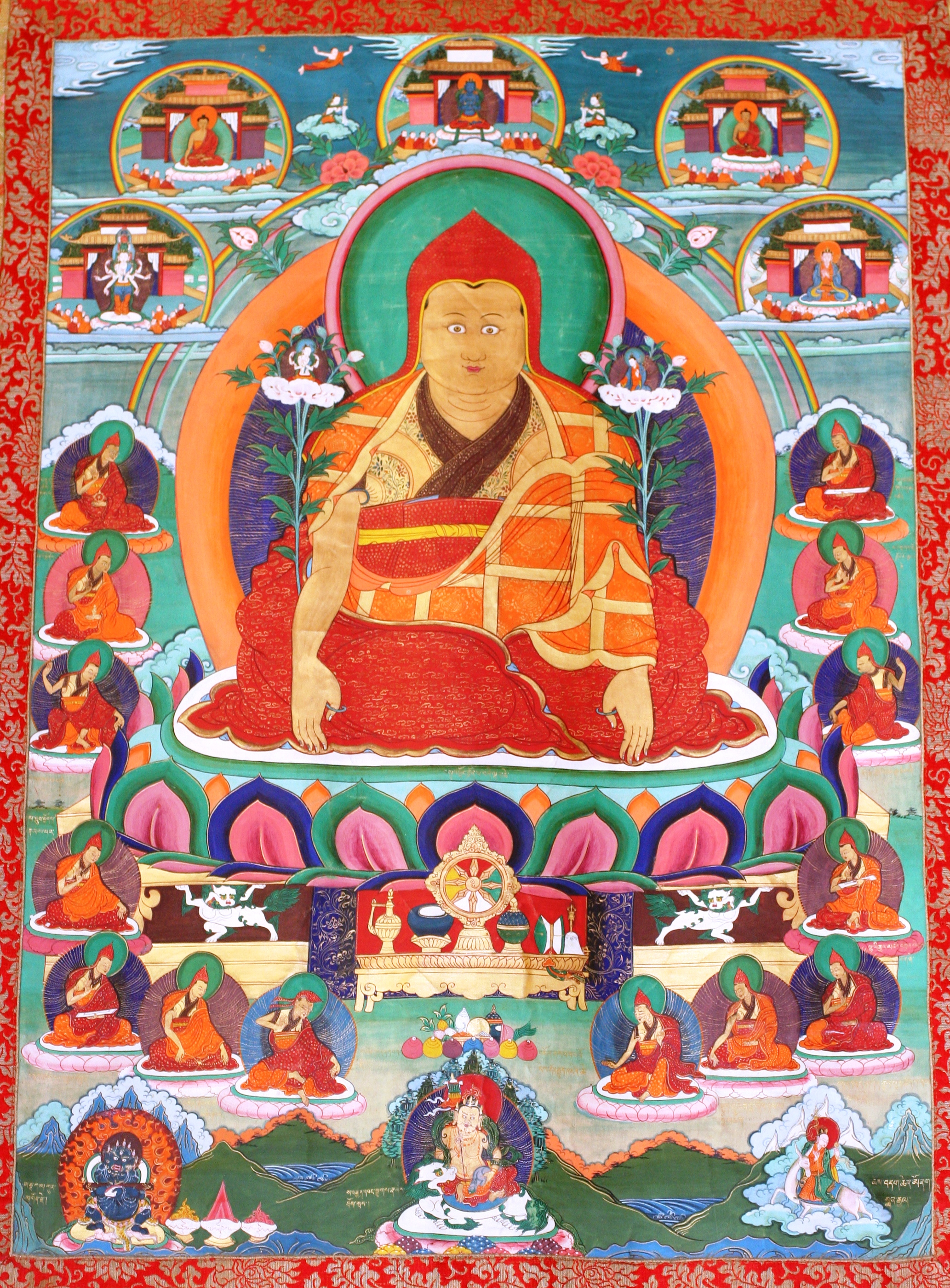|
Yumo Mikyo Dorje
Yumo Mikyö Dorjé () was a student of the Kashmiri scholar Somanātha and an 11th-century Kalachakra master. Yumo Mikyö Dorjé is regarded as one of the earliest Tibetan articulators of a shentong view of śūnyatā — an understanding of the absolute radiant nature of reality. Emphasized within the Kalachakra tantra and Gautama Buddha's teachings on Buddha-nature in the so-called Third Turning of the Wheel of the Dharma of the Yogacara school of Buddhism philosophy; this view later became emblematic of the Jonang tradition of Tibetan Buddhism Tibetan Buddhism is a form of Buddhism practiced in Tibet, Bhutan and Mongolia. It also has a sizable number of adherents in the areas surrounding the Himalayas, including the Indian regions of Ladakh, Gorkhaland Territorial Administration, D .... References External links Early Jonangpa in Tibet, Jonang Foundation Scholars of Buddhism from Tibet Jonang Lamas Tibetan Buddhist spiritual teachers Year of birth miss ... [...More Info...] [...Related Items...] OR: [Wikipedia] [Google] [Baidu] |
Kashmir
Kashmir ( or ) is the Northwestern Indian subcontinent, northernmost geographical region of the Indian subcontinent. Until the mid-19th century, the term ''Kashmir'' denoted only the Kashmir Valley between the Great Himalayas and the Pir Panjal Range. The term has since also come to encompass a larger area that includes the Indian-administered territories of Jammu and Kashmir (union territory), Jammu and Kashmir and Ladakh, the Pakistani-administered territories of Azad Kashmir and Gilgit-Baltistan, and the Chinese-administered territories of Aksai Chin and the Trans-Karakoram Tract. Quote: "Kashmir, region of the northwestern Indian subcontinent. It is bounded by the Uygur Autonomous Region of Xinjiang to the northeast and the Tibet Autonomous Region to the east (both parts of China), by the Indian states of Himachal Pradesh and Punjab to the south, by Pakistan to the west, and by Afghanistan to the northwest. The northern and western portions are administered by Pakistan a ... [...More Info...] [...Related Items...] OR: [Wikipedia] [Google] [Baidu] |
Kalachakra
''Kālacakra'' () is a Polysemy, polysemic term in Vajrayana, Vajrayana Buddhism and Hinduism that means "wheel of time" or "time cycles". "''Kālacakra''" is also the name of a series of Buddhist texts and a major practice lineage in History of Buddhism in India, Indian Buddhism and Tibetan Buddhism. The tantra is considered to belong to the unexcelled yoga (''Anuttarayoga Tantra, anuttara-yoga'') class. Kālacakra also refers both to a patron Tantra, tantric deity or yidam in Vajrayana and to the philosophies and yogas of the Kālacakra tradition. The tradition's origins are in India and its most active later history and presence has been in Tibet. The tradition contains teachings on cosmology, theology, philosophy, sociology, soteriology, myth, prophecy, Ayurveda, medicine and yoga. It depicts a mythic reality whereby cosmic and socio-historical events correspond to processes in the bodies of individuals. These teachings are meant to lead to a transformation of one's body and ... [...More Info...] [...Related Items...] OR: [Wikipedia] [Google] [Baidu] |
Shentong
''Rangtong'' and ''shentong'' are two distinctive views on emptiness ( sunyata) and the two truths doctrine within Tibetan Buddhism. Rangtong (; "empty of self-nature") is a philosophical term in Tibetan Buddhism which is used by Tibetan defenders of shentong, like Dölpopa, to distinguish the majority Madhyamaka teaching on the nature of śūnyatā or "emptiness", namely that all phenomenon are empty of an enduring and/or unchanging essence or "self," and that this emptiness is not an absolute reality, but a mere nominal characterisation of phenomena. It is related to the '' prasangika'' approach, which argues that no positive statements should be made to deconstruct the notion of inherent existence, but only arguments which show the logical implications and absurdity of statements. This position is the mainstream Gelugpa interpretation of Madhyamaka, one of the main Mahayana schools, which dominates Vajrayana Buddhism. ''Shentong'' ( Wylie: ''gzhan stong'', "emptiness of othe ... [...More Info...] [...Related Items...] OR: [Wikipedia] [Google] [Baidu] |
śūnyatā
''Śūnyatā'' ( ; ; ), translated most often as "emptiness", " vacuity", and sometimes "voidness", or "nothingness" is an Indian philosophical concept. In Buddhism, Jainism, Hinduism, and other Indian philosophical traditions, the concept has multiple meanings depending on its doctrinal context. It is either an ontological feature of reality, a meditative state, or a phenomenological analysis of experience. In Theravāda Buddhism, ' often refers to the non-self (Pāli: ', Sanskrit: ') nature of the five aggregates of experience and the six sense spheres. ' is also often used to refer to a meditative state or experience. In Mahāyāna Buddhism, ' refers to the tenet that "all things are empty of intrinsic existence and nature ('' svabhava'')", but may also refer to the Buddha-nature teachings and primordial or empty awareness, as in Dzogchen, Shentong, or Chan. Etymology ''Śūnyatā'' is usually translated as "devoidness", "emptiness", "hollow", "hollowness", "v ... [...More Info...] [...Related Items...] OR: [Wikipedia] [Google] [Baidu] |
Gautama Buddha
Siddhartha Gautama, most commonly referred to as the Buddha (),* * * was a śramaṇa, wandering ascetic and religious teacher who lived in South Asia during the 6th or 5th century BCE and founded Buddhism. According to Buddhist legends, he was born in Lumbini, in what is now Nepal, to royal parents of the Shakya clan, but Great Renunciation, renounced his Householder (Buddhism), home life to live as a wandering ascetic. After leading a life of mendicancy, asceticism, and meditation, he attained Nirvana (Buddhism), nirvana at Bodh Gaya, Bodh Gayā in what is now India. The Buddha then wandered through the lower Indo-Gangetic Plain, teaching and building a Sangha, monastic order. Buddhist tradition holds he died in Kushinagar and reached ''parinirvana'' ("final release from conditioned existence"). According to Buddhist tradition, the Buddha taught a Middle Way between sensual indulgence and severe asceticism, leading to Vimutti, freedom from Avidyā (Buddhism), ignora ... [...More Info...] [...Related Items...] OR: [Wikipedia] [Google] [Baidu] |
Buddha-nature
In Buddhist philosophy and soteriology, Buddha-nature ( Chinese: , Japanese: , , Sanskrit: ) is the innate potential for all sentient beings to become a Buddha or the fact that all sentient beings already have a pure Buddha-essence within themselves.Heng-Ching ShihThe Significance Of 'Tathagatagarbha' – A Positive Expression Of 'Sunyata'/ref> "Buddha-nature" is the common English translation for several related Mahāyāna Buddhism, Buddhist terms, most notably ''tathāgatagarbha'' and ''buddhadhātu'', but also ''sugatagarbha,'' and ''buddhagarbha''. ''Tathāgatagarbha'' can mean "the womb" or "embryo" (''garbha'') of the "thus-gone one" (''Tathagata, tathāgata''), and can also mean "containing a ''tathāgata''"''. Buddhadhātu'' can mean "buddha-element", "buddha-realm", or "buddha-substrate". Buddha-nature has a wide range of (sometimes conflicting) meanings in Indian Buddhism and later in East Asian Buddhism, East Asian and Tibetan Buddhism, Tibetan Buddhist literatur ... [...More Info...] [...Related Items...] OR: [Wikipedia] [Google] [Baidu] |
Three Turnings Of The Wheel Of Dharma
Buddhist Doctrinal Classification refers to various systems used by Mahayana, Mahāyāna Buddhist traditions to classify and organize the numerous texts and teachings that have developed over the history of Buddhism. According to Buddhist studies, buddhologist Peter Gregory, these classification systems fulfill three interwoven roles for Buddhist traditions: Hermeneutics, hermeneutical, Sectarianism, sectarian, and Soteriology, soteriological. From an hermeneutical standpoint, they function as a method of organizing Buddhist texts both chronologically and hierarchically, thereby producing a doctrinal structure that is internally coherent and logically consistent. In its sectarian application, different Buddhist schools evaluate and order scriptures based on their own doctrinal priorities, using this to legitimize their specific traditions. From a soteriological perspective, classification schemas map out a graded path of spiritual development, wherein the practitioner’s insight e ... [...More Info...] [...Related Items...] OR: [Wikipedia] [Google] [Baidu] |
Yogacara
Yogachara (, IAST: ') is an influential tradition of Buddhist philosophy and psychology emphasizing the study of cognition, perception, and consciousness through the interior lens of meditation, as well as philosophical reasoning (hetuvidyā). Yogachara was one of the two most influential traditions of Mahayana, Mahayana Buddhism in India, along with Madhyamaka. The compound ''Yogācāra'' literally means "practice of yoga", or "one whose practice is yoga", hence the name of the school is literally "the school of the yogins". Yogācāra was also variously termed ''Vijñānavāda'' (the doctrine of consciousness), ''Vijñaptivāda'' (the doctrine of ideas or percepts) or ''Vijñaptimātratā-vāda'' (the doctrine of 'mere representation'), which is also the name given to its major theory of mind which seeks to deconstruct how we perceive the world. There are several interpretations of this main theory: various forms of Idealism, as well as a Phenomenology (philosophy), phenomen ... [...More Info...] [...Related Items...] OR: [Wikipedia] [Google] [Baidu] |
Jonang
The Jonang () is a school of Indo-Tibetan Buddhism. Its origins in Tibet can be traced to the early 12th century master Yumo Mikyo Dorje. It became widely known through the work of the popular 14th century figure Dolpopa Sherab Gyaltsen. The Jonang school's main practice is the ''Kālacakra tantra'' (''Wheel of Time Tantra''), and they are widely known for their defense of the philosophy known as shentong ("empty of other"). After a period of influence, the Jonang tradition suffered a series of reversals, partly due to its suppression by the politically dominant Gelug school under the Fifth Dalai Lama in the 17th century. Jonang did survive in Amdo, from which they eventually re-established themselves in other regions like Golok, Nakhi, and Kham. They have continued practicing uninterrupted to this day. An estimated 5,000 monks and nuns of the Jonang tradition practice today in these areas. However, their teachings were limited to these regions until the Rimé moveme ... [...More Info...] [...Related Items...] OR: [Wikipedia] [Google] [Baidu] |
Tibetan Buddhism
Tibetan Buddhism is a form of Buddhism practiced in Tibet, Bhutan and Mongolia. It also has a sizable number of adherents in the areas surrounding the Himalayas, including the Indian regions of Ladakh, Gorkhaland Territorial Administration, Darjeeling, Sikkim, and Arunachal Pradesh, as well as in Nepal. Smaller groups of practitioners can be found in Central Asia, some regions of China such as Northeast China, Xinjiang, Inner Mongolia and some regions of Russia, such as Tuva, Buryatia, and Kalmykia. Tibetan Buddhism evolved as a form of Mahayana, Mahāyāna Buddhism stemming from the latest stages of Indian Buddhism (which included many Vajrayana, Vajrayāna elements). It thus preserves many Indian Buddhist Tantra, tantric practices of the Gupta Empire, post-Gupta Medieval India, early medieval period (500–1200 CE), along with numerous native Tibetan developments. In the pre-modern era, Tibetan Buddhism spread outside of Tibet primarily due to the influence of the Mongol Emp ... [...More Info...] [...Related Items...] OR: [Wikipedia] [Google] [Baidu] |
Scholars Of Buddhism From Tibet
A scholar is a person who is a researcher or has expertise in an academic discipline. A scholar can also be an academic, who works as a professor, teacher, or researcher at a university. An academic usually holds an Postgraduate education, advanced degree or a terminal degree, such as a master's degree or a doctorate (PhD). Independent scholars and public intellectuals work outside the academy yet may publish in academic journals and participate in scholarly public discussion. Definitions In contemporary English usage, the term ''scholar'' sometimes is equivalent to the term ''academic'', and describes a university-educated individual who has achieved intellectual mastery of an academic discipline, as instructor and as researcher. Moreover, before the establishment of universities, the term ''scholar'' identified and described an intellectual person whose primary occupation was professional research. In 1847, minister Emanuel Vogel Gerhart spoke of the role of the scholar in socie ... [...More Info...] [...Related Items...] OR: [Wikipedia] [Google] [Baidu] |
Lamas
Lamas may refer to: * The plural form of Lama, a title for a teacher of the Dharma in Tibetan Buddhism. Places * Lamas Province, Peru ** Lamas District ** Lamas, Peru, the capital of Lamas Province and seat of Lamas District * Lamas (Braga), a parish in Braga District, Portugal * Lamas (Cadaval), a parish in Cadaval Municipality, Lisbon District, Portugal * Lamas (Miranda do Corvo), a parish in Miranda do Corvo Municipality, Coimbra District, Portugal * Lamas (Macedo de Cavaleiros), a parish in Macedo de Cavaleiros Municipality, Bragança District, Portugal * Santa Maria de Lamas, a parish in Aveiro District, Portugal * Lamas, Norfolk, a village in England Other uses * Lamas (surname) * Lamas Quechua, a variety of Quechuan language * London and Middlesex Archaeological Society (LAMAS) See also *Lama (other) *Lammas, a Christian holiday *Llama (other) A llama is a South American animal. Llama may also refer to: * Llama (language model), a large language m ... [...More Info...] [...Related Items...] OR: [Wikipedia] [Google] [Baidu] |









